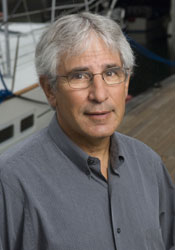 |

For further information, contact the MBL Communications Office at (508) 289-7423 or e-mail us at comm@mbl.edu
For Immediate Release: November 17, 2008
Contact: Diana Kenney, Marine Biological Laboratory, 508-428-2722; dkenney@mbl.edu
Antibiotics Can Cause Pervasive, Persistent Changes to the Microbial Community in the Human Gut, MBL and Stanford Scientists Report
 |
 |
Mitchell Sogin
The Sogin Lab
Citation:
Dethlefsen, L., S. Huse, M.L. Sogin, and D.A. Relman (Nov. 18, 2008). The pervasive effects of an antibiotic on the human gut microbiota, as revealed by deep 16S rRNA sequencing. PLoS Biology Vol. 6, No. 11, e280 doi:10.1371/ journal.pbio.0060280.
|
|
MBL, WOODS HOLE, MA—Using a novel technique developed by Mitchell Sogin of the Marine Biological Laboratory (MBL) to identify different types of bacteria, scientists have completed the most precise survey to date of how microbial communities in the human gut respond to antibiotic treatment.
Sogin, director of the MBL’s Josephine Bay Paul Center, and Susan Huse of the MBL, along with David Relman and Les Dethlefsen of Stanford University, identified pervasive changes in the gut microbial communities of three healthy humans after a five-day course of the antibiotic Ciprofloxacin. Their results are reported in the Nov. 18 issue of PloS Biology.
Using very conservative criteria, the scientists identified at least 3,300 to 5,700 different taxa (genetically distinct types) of bacteria in the human distal gut, and antibiotic treatment influenced the abundance of about a third of those taxa.
“You clearly get shifts in the structure of the microbial community with antibiotic treatment,” says Sogin. “Some bacteria that were in low abundance prior to treatment may become more abundant, and bacteria that were dominant may decrease in abundance. When you get these shifts, they may be persistent. Some individuals may recover quickly, and others won’t recover for many months.”
In all the individuals tested in this study, the bacterial community recovered and closely resembled its pre-treatment state within four weeks after the antibiotic course ended, but several bacterial taxa failed to recover within six months.
This raises questions about the health effects of perturbations to the human-microbial symbiosis in the gut, such as may occur with antibiotic treatment. Because specific microbial populations mediate many chemical transformations in the gut—and previous studies have related these processes to cancer and obesity, among other conditions—changes in the composition of the gut microbiota could have important, but as yet undiscovered, health effects.
“When you change the microbial population structure in the gut, you may affect how that population is keeping indigenous pathogens at manageable levels,” says Sogin. Bacteria that do not normally cause problems may begin to grow more rapidly, and cause disease.
The study is part of a large, international effort to fully characterize the microbiota in the human gut, which is the highest-density natural bacterial ecosystem known. Up to 100 trillion microbial cells reside in the gut, and this community plays essential roles in nutrition, development, metabolism, pathogen resistance, and regulation of immune responses.
Until recently, descriptions of human-associated microbiota were constrained by techniques of cultivating (and thus identifying) bacteria. Less than 20-40% of the microbes in the human distal gut, for example, have been cultured in the laboratory. Since the late 1980s, however, cultivation-independent microbial surveys have been developed that identify community members by genetic sequencing. Sogin’s technique, for example, which was used in this study, characterizes microbial populations by sequencing short, hypervariable regions of one gene common to all microbes, the 16S rRNA gene. This pyrosequencing technique reveals greater taxonomic richness in microbial samples at a fraction of the cost of traditional sequencing technologies.
The MBL is a leading international, independent, nonprofit institution dedicated to discovery and to improving the human condition through creative research and education in the biological, biomedical and environmental sciences. Founded in 1888 as the Marine Biological Laboratory, the MBL is the oldest private marine laboratory in the Western Hemisphere. For more information, visit www.MBL.edu.
|